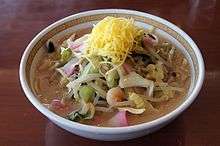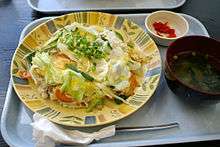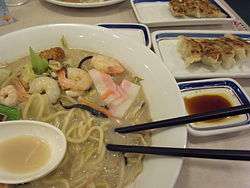Champon
Champon (ちゃんぽん, Chanpon), also known as Chanpon, is a noodle dish that is a regional cuisine of Nagasaki, Japan. There are different versions in Japan, Korea and China. The dish was inspired by the cuisine of China. Champon is made by frying pork, seafood and vegetables with lard; a soup made with chicken and pig bones is then added. Ramen noodles made especially for champon are added and then boiled. Unlike other ramen dishes, only one pan is needed as the noodles are boiled in the soup. Depending on the season and the situation, the ingredients differ. Hence the taste and style may depend on the location and time of year.
 Original Shikairō Champon | |
| Type | Noodle soup |
|---|---|
| Place of origin | Japan |
| Region or state | Nagasaki |
| Main ingredients | ramen noodles, frying pork, seafood, and vegetables |
Although Nagasaki Champon is the best-known rendition, there are other variations found in Japan. Ankake no Champon is a soy-sauce based variant found in Tottori, Shimane Prefectures, as well as the city of Amagasaki in Hyōgo Prefecture. In the city of Akita, a version with miso broth is served, with the soup filling the bowl almost to the point of overflowing.
In Okinawa, Champon is a rice dish where assorted vegetables, thinly-sliced meat (pork, luncheon meat or corned beef hash) and scrambled egg are fried and served on top of rice.

The Korean Jjamppong is a similar noodle dish with a spicy seafood broth.
History
Champon was first served by Shikairō (四海楼, literally “Four Seas House”), a Chinese restaurant founded in Nagasaki in 1899. According to the restaurant's website, this was based on a dish in Fujian cuisine, 湯肉絲麵[1] (pronounced as tó̤ng nṳ̀ sí mīng in Min Bei), literally “hot-water meat thread noodles”. In the middle of the Meiji era (late 1800s, early 1900s), the owner saw a need for a cheap, filling meal that suited the palates of hundreds of Chinese students who came to Japan for school. Nowadays, champon is a popular specialty food (or meibutsu) of Nagasaki.[2]
Etymology
| Look up champon or ちゃんぽん in Wiktionary, the free dictionary. |
There are several theories as to the origin of the word champon. One theory is that it was derived from the Hokkien word chia̍h-pn̄g (食飯), which means "to eat a meal",[1][2] which might fit the sense of “a hearty noodle dish made of mixed ingredients”. Another theory is that the word was derived from the word campur from Malay or Indonesian, meaning “mixed” (see Nasi campur), which would fit the term's older sense of “mixed together”.
The original sense of “mixed together” appears in texts from the mid-1700s.[3] Some Japanese dictionaries trace this to Chinese term 攙和 ("to mix"),[3][4][5] pronounced as chham-hô in modern Min-Nan and as chānhuò in modern Mandarin.
Usage to refer to the food item appears from the late 1800s or early 1900s, apparently originating from the Shikairō Chinese restaurant in Nagasaki.[6][7]
See also
References
| Wikimedia Commons has media related to Champon. |
- ちゃんぽんの由来 (Chanpon no Yurai, “The Origins of Chanpon”) (in Japanese) Archived 2007-05-01 at the Wayback Machine. Official website of the Shikairō Restaurant
- "Nagasaki city tourism guide". Nagasaki Tourism.
- 1988, 国語大辞典(新装版) (Kokugo Dai Jiten, Revised Edition) (in Japanese), Tōkyō: Shogakukan, entry available online here
- 1995, 大辞泉 (Daijisen) (in Japanese), Tōkyō: Shogakukan, ISBN 4-09-501211-0
- 1997, 新明解国語辞典 (Shin Meikai kokugo jiten), Fifth Edition (in Japanese), Tōkyō: Sanseidō, ISBN 4-385-13143-0
- Entry in the 和・洋・中・エスニック 世界の料理がわかる辞典 (Wa-Yō-Chū-Esunikku Sekai no Ryōri ga Wakaru Jiten, “Japanese-Western-Chinese-Ethnic: Dictionary for Understanding World Cooking”; in Japanese)
- Entry in the 日本の郷土料理がわかる辞典 (Nihon no Kyōdo Ryōri ga Wakaru Jiten, “Dictionary for Understanding Japanese Home-town Cooking”; in Japanese)

.jpg)